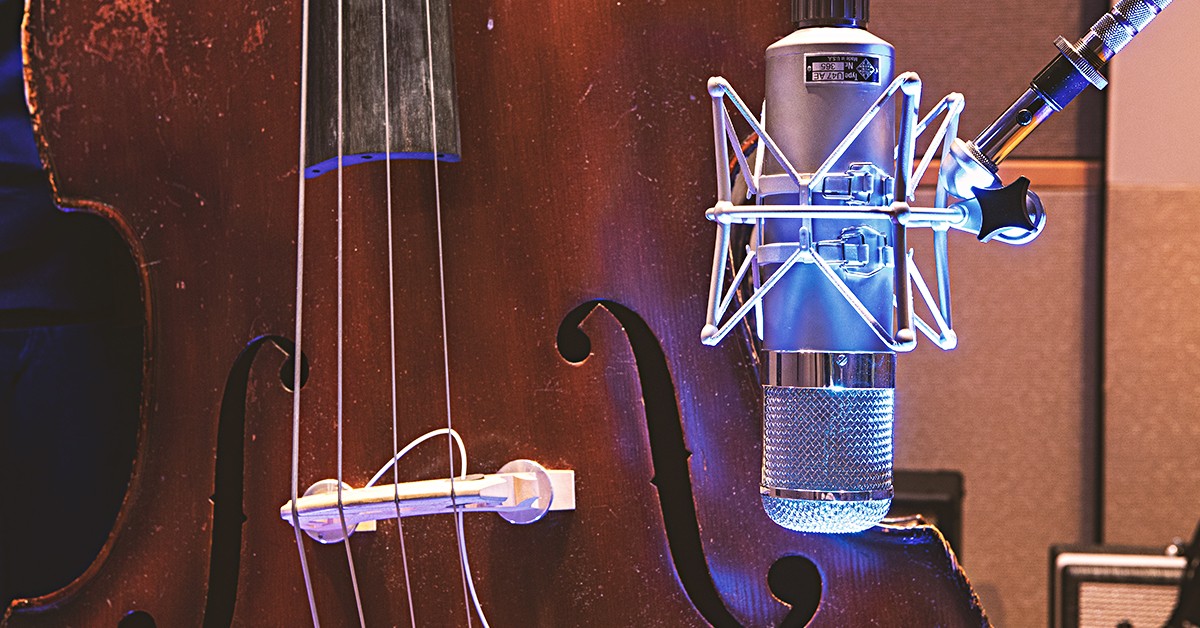Acoustic Bass Masterclass

Course Content
Chapter 1: Introduction to Acoustic Bass Recording
-
Introduction to the importance of recording acoustic bass guitar effectively
00:00 -
Target audience and skill level
00:00 -
Goals and outcomes of the master class
00:00 -
Anatomy of the acoustic bass guitar
00:00 -
Differentiating between various acoustic bass designs (e.g., upright, acoustic-electric)
00:00 -
Tonal considerations and characteristics of acoustic bass guitars
00:00 -
Techniques for preserving the natural resonance and warmth of acoustic bass
00:00 -
The impact of room acoustics on acoustic bass recordings
00:00 -
Strategies for achieving a balanced and authentic representation of the instrument
00:00 -
Addressing potential issues such as low-end frequency management
00:00 -
Dealing with string noise, fret squeaks, and other extraneous sounds
00:00 -
Strategies for recording in challenging acoustic environments
00:00
Chapter 2: Mic Selection and Placement
-
Exploring microphone options suitable for acoustic bass recording
00:00 -
The characteristics of condenser vs. dynamic microphones for acoustic bass
00:00 -
Considerations for ribbon microphones and other specialized options
00:00 -
Placing microphones close to the acoustic bass for detailed capture
00:00 -
Techniques for finding the sweet spot on the instrument
00:00 -
Addressing proximity effect and managing low-frequency response
00:00 -
Creating a stereo image for acoustic bass recordings
00:00 -
Techniques for XY, ORTF, and spaced pair stereo configurations
00:00 -
Achieving a natural and immersive stereo sound
00:00 -
Utilizing room microphones to capture the ambient sound of the space
00:00 -
Finding an optimal balance between close and room mics
00:00 -
Techniques for achieving a sense of space in the recording
00:00 -
Strategies for blending multiple microphone signals
00:00 -
Achieving tonal variety through different mic combinations
00:00 -
Tips for phase coherence when using multiple microphones
00:00 -
Tips for phase coherence when using multiple microphones
00:00
Chapter 3: Direct Boxes and Preamps for Acoustic Bass
-
Overview of direct boxes and their application in acoustic bass recording
00:00 -
Choosing between passive and active DI boxes based on the instrument and context
00:00 -
Benefits of using a DI box in live and studio settings
00:00 -
Factors to consider when choosing a DI box for acoustic bass
00:00 -
Features such as impedance matching, ground lift, and phase inversion
00:00 -
Experimenting with different DI boxes for tonal shaping
00:00 -
The role of acoustic preamps in enhancing the signal from the acoustic bass
00:00 -
EQ and tone control options on preamps for shaping the sound
00:00 -
Strategies for using preamps to achieve a natural and transparent tone
00:00 -
Techniques for blending the direct signal from a DI box with the microphone signal
00:00 -
Achieving a balanced and nuanced sound through signal blending
00:00 -
Tips for avoiding phase issues when combining DI and mic signals
00:00 -
Exploring external preamps to add color and character to acoustic bass recordings
00:00 -
Tips for selecting preamps based on tonal preferences and musical styles
00:00 -
Balancing the desire for a clean signal with creative tonal shaping
00:00
Chapter 4: Acoustic Bass Playing Techniques
-
Different playing styles and techniques employed on the acoustic bass
00:00 -
Fingerstyle, pizzicato, and arco playing techniques
00:00 -
The impact of playing style on tone and articulation in recordings
00:00 -
Techniques for capturing the nuances of fingerstyle playing
00:00 -
Adjusting mic placement to highlight finger attack and sustain
00:00 -
Tips for achieving clarity and definition in fingerstyle passages
00:00 -
Strategies for recording percussive elements in pizzicato playing
00:00 -
Capturing the attack and release of the strings in rhythmic passages
00:00 -
Addressing challenges related to string slaps and pops
00:00 -
Techniques for recording bowed passages on the acoustic bass
00:00 -
Adjusting mic placement to capture the full range and dynamics of arco playing
00:00 -
Tips for achieving expressive and emotive bowing tones
00:00 -
Managing the dynamic range of the acoustic bass in recording
00:00 -
Techniques for controlling volume disparities between soft and loud passages
00:00 -
Utilizing compression and other tools for dynamic consistency
00:00
Chapter 5: Room Acoustics and Environment
-
Understanding the impact of room acoustics on acoustic bass recordings
00:00 -
Addressing challenges related to room reflections and resonance
00:00 -
Strategies for optimizing the recording environment for acoustic bass
00:00 -
Implementing acoustic treatment to minimize undesirable reflections
00:00 -
Strategies for creating a controlled acoustic environment for recording
00:00 -
The role of bass traps and diffusers in improving recording spaces
00:00 -
Experimenting with room mic placement for optimal capture of the acoustic space
00:00 -
Adjusting the balance between direct and ambient sound
00:00 -
Tips for achieving a natural and immersive room sound in the recording
00:00 -
Techniques for preserving the natural resonance of an upright bass
00:00 -
Adjusting mic placement to capture the resonant qualities of the instrument body
00:00 -
Utilizing room mics to enhance the sense of space and depth
00:00 -
Tips for achieving quality acoustic bass recordings in home studio setups
00:00 -
Techniques for mitigating challenges related to limited space and resources
00:00 -
Using creative solutions to enhance the acoustics of home recording environments
00:00
Chapter 6: Advanced Acoustic Bass Recording Techniques
-
Exploring advanced stereo miking techniques for upright bass
00:00 -
Techniques for achieving a wide and immersive stereo image
00:00 -
Utilizing mid-side (M/S) configurations and other stereo techniques
00:00 -
Techniques for layering multiple recordings to create a fuller and richer sound
00:00 -
Tips for doubling acoustic bass parts to add depth and complexity
00:00 -
Strategies for achieving tight synchronization in layered recordings
00:00 -
Strategies for recording acoustic bass in ensemble settings
00:00 -
Techniques for capturing the interaction between multiple bass instruments
00:00 -
Addressing challenges related to phase coherence in ensemble recordings
00:00 -
Techniques for capturing the nuances of acoustic bass in jazz performances
00:00 -
Strategies for recording classical upright bass in orchestral and chamber settings
00:00 -
Tips for achieving clarity and definition in intricate bass passages
00:00 -
Exploring the use of effects pedals in acoustic bass recording
00:00 -
Techniques for creative processing without compromising the natural sound
00:00 -
Tips for using EQ, compression, and other processors in post-production
00:00
Chapter 7: Editing and Processing Acoustic Bass Recordings
-
Exploring advanced editing tools and software for refining bass performances
00:00 -
Tightening up timing issues and enhancing the overall groove in bass tracks
00:00 -
Balancing the need for precision with preserving the natural feel of the performance
00:00 -
Techniques for comping multiple takes to create the ideal acoustic bass performance
00:00 -
Strategies for selecting the best sections from various takes to construct a cohesive track
00:00 -
Maintaining the flow and continuity of the bassline through effective comping
00:00 -
Strategies for addressing intonation challenges in acoustic bass recordings
00:00 -
Techniques for minimizing fret noise and string squeaks during editing
00:00 -
Tips for achieving a clean and polished final recording
00:00 -
Strategies for using equalization to shape the tonal characteristics of acoustic bass recordings
00:00 -
Applying compression to control dynamics and enhance sustain without sacrificing natural dynamics
00:00 -
Techniques for achieving a balanced and impactful acoustic bass sound in the mix
00:00 -
Incorporating reverb and ambient effects to enhance the sense of space in acoustic bass recordings
00:00 -
Techniques for selecting appropriate reverbs and creating a natural acoustic environment
00:00 -
Tips for using ambient effects creatively without overpowering the instrument
00:00
Chapter 8: Mixing and Mastering Acoustic Bass
-
Techniques for achieving a balanced acoustic bass mix that complements other instruments
00:00 -
Strategies for setting appropriate bass levels in different musical contexts
00:00 -
Tips for avoiding common pitfalls such as excessive bass dominance or inconsistency in levels
00:00 -
Creative panning techniques for acoustic bass instruments to enhance stereo width
00:00 -
Strategies for placing bass elements in the mix to create a balanced spatial image
00:00 -
Exploring stereo effects and widening for specific genres or artistic choices
00:00 -
Advanced equalization techniques for addressing frequency conflicts and enhancing the overall bass tone
00:00 -
Strategies for managing low-end frequencies to prevent muddiness and ensure clarity
00:00 -
Using surgical EQ to address specific tonal characteristics or correct problematic frequencies
00:00 -
Advanced compression techniques for shaping the dynamics of the acoustic bass in the mix
00:00 -
Sidechain compression applications to enhance clarity and prevent frequency clashes
00:00 -
Tips for using multiband compression to address specific frequency ranges in the bass
00:00 -
Discussing the role of acoustic bass in the mastering process and its impact on the final mix
00:00 -
Strategies for achieving a balanced and cohesive acoustic bass sound across an entire album or project
00:00 -
Addressing potential challenges such as bass transients and overall tonal balance during mastering
00:00
Chapter 9: Acoustic Bass Recording in Different Genres
-
Approaches to capturing the nuanced and dynamic qualities of jazz acoustic bass performances
00:00 -
Strategies for achieving clarity and articulation in complex jazz bass lines
00:00 -
Tips for preserving the natural dynamics and subtleties of jazz bass recordings
00:00 -
Techniques for capturing the rhythmic and melodic elements of acoustic bass in folk and bluegrass music
00:00 -
Strategies for achieving a balanced and supportive bass presence in acoustic ensembles
00:00 -
Tips for blending acoustic bass with other traditional instruments in folk and bluegrass recordings
00:00 -
Approaches to recording classical upright bass in orchestral and chamber settings
00:00 -
Strategies for capturing the expressiveness and richness of classical bass performances
00:00 -
Tips for achieving clarity and definition in intricate classical bass passages
00:00 -
Techniques for recording acoustic bass in world music contexts
00:00 -
Strategies for capturing the unique tonal characteristics and playing styles of different cultures
00:00 -
Tips for integrating acoustic bass into diverse world music ensembles
00:00 -
Exploring unconventional techniques for recording acoustic bass in experimental genres
00:00 -
Techniques for capturing extended techniques, prepared bass, and unconventional playing styles
00:00 -
Tips for pushing the boundaries of traditional acoustic bass recording in contemporary music
00:00
Chapter 10: Acoustic Bass Recording Studio Session Walkthrough
-
– Pre-session communication and planning with the artist or producer
00:00 -
– Setting up the acoustic bass, microphones, and signal chain for the recording session
00:00 -
– Establishing a comfortable and inspiring environment for the bassist
00:00 -
– Selecting microphones based on the desired tonal characteristics
00:00 -
– Experimenting with mic placement to capture the optimal sound from the acoustic bass
00:00 -
– Using a combination of close mics and room mics for a versatile recording
00:00 -
– Setting up effective monitoring for the bassist and recording engineer
00:00 -
– Addressing headphone mixes and ensuring optimal playback during the session
00:00 -
– Strategies for providing real-time feedback to the bassist for performance adjustments
00:00 -
– Tailoring recording approaches for different sections of a song (verse, chorus, bridge)
00:00 -
– Adjusting playing techniques and tones to serve the song’s dynamics and arrangement
00:00 -
– Capturing variations in playing style for added expressiveness in the final mix
00:00 -
– Identifying and addressing issues that may arise during the recording process
00:00 -
– Encouraging iterative recording for refining and enhancing bass performances
00:00 -
– Maintaining a positive and collaborative atmosphere throughout the recording session
00:00
Student Ratings & Reviews

No Review Yet
